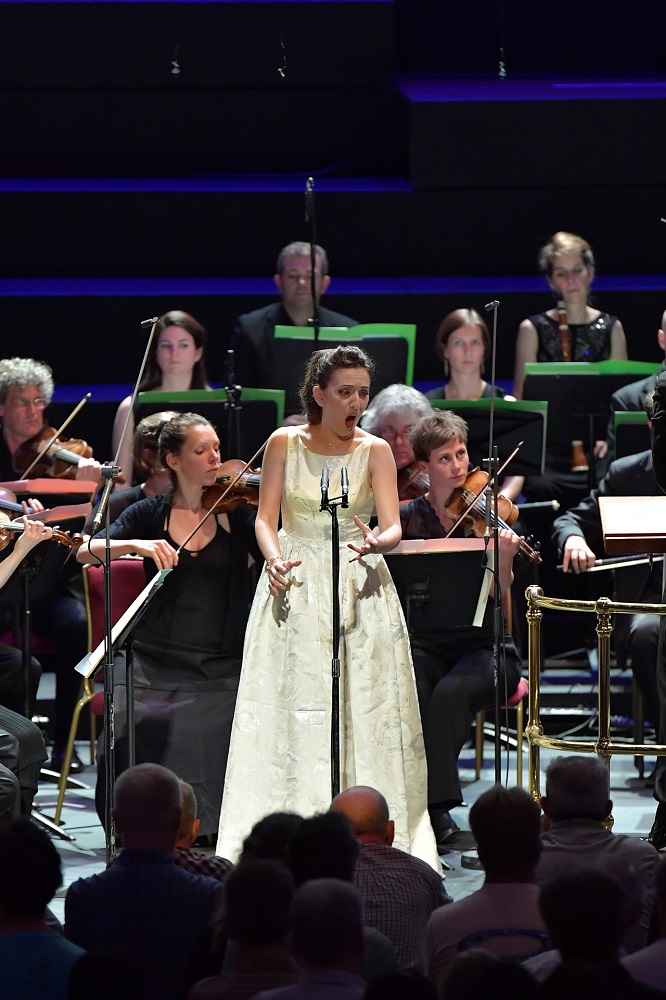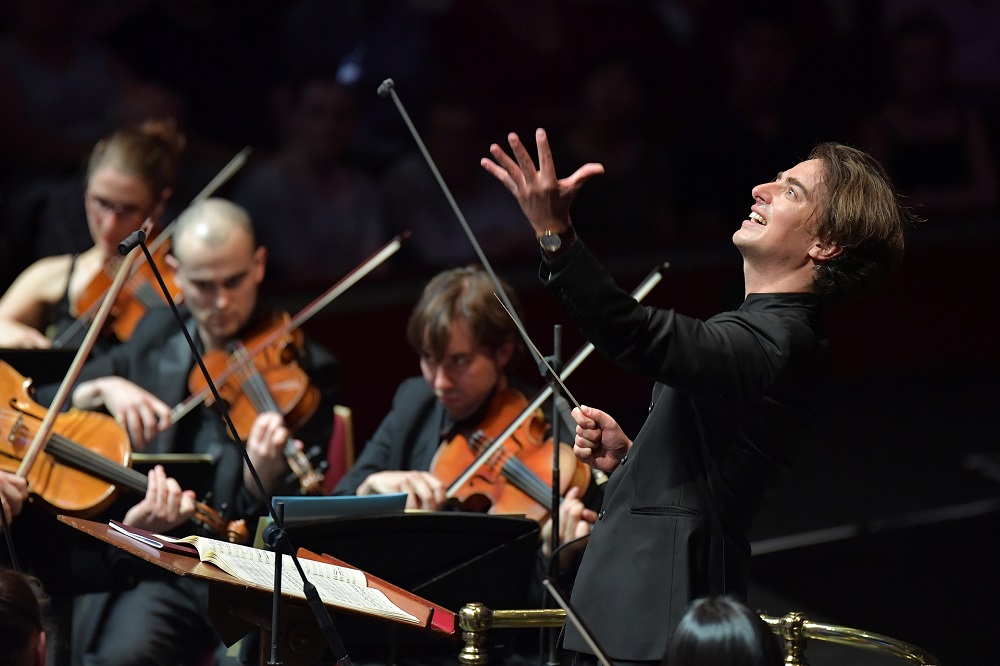Prom 9: Feola, Le Cercle de l'Harmonie, Rhorer | reviews, news & interviews
Prom 9: Feola, Le Cercle de l'Harmonie, Rhorer
Prom 9: Feola, Le Cercle de l'Harmonie, Rhorer
Vivacious Italian soprano and first clarinet excel in Mozart and Mendelssohn
It's never easy readjusting to the weird and sometimes wonderful acoustics of Albert's colosseum at Proms time, least of all when the first thing you hear there comes from a period-instrument band. Tuning in to Jérémie Rhorer's Le Cercle de l'Harmonie didn't take too long, however, while the urgent projection and diction of a splendid new Italian soprano on the block, Rosa Feola, did the hall proud.
Rhorer (pictured below) announced his intentions in a spruce, articulate Adagio introduction to Mozart's Symphony No. 39, strings rushing with swift clarity down the scales. Sustained notes, vibrato-free, have more trouble carrying in tha Albert Hall, especially when compounded by intonation problems in leader Brian Dean's obbligato role in a Mendelssohn concert aria. Woodwind tuning wasn't always felicitous either – those disappointingly dull authentic flutes and bassoons were a real disappointment in Mozart – while natural horns created some problems here and something really horrible in the scherzo trio of Mendelssohn's "Italian" Symphony. A question to the more historically informed: wouldn't Mendelssohn have written for valves in 1833? Update: see comment below - he didn't.
Bliss, though, arrived in the shape of first clarinet Nicola Boud, twice ornamenting her rustic role at the heart of Mozart's Minuet, deliciously swift. Rhorer is a real phrase-shaper, though you felt that more of the pain in those minor-key lunges of the slow movement might have been plumbed, and the Mendelssohn symphony was elegant rather than fiery – more chiaroscuro than bright blue Italian skies. Here we definitely wanted more vivacious body from the strings in the outer movements.
Funny, too, how a young conductor at the top of his game doesn't think of practicalities: flipping the hair out of his eyes with his batonless hand must have got in the way of total concentration. I'll never forget Martyn Brabbins' advice to an Israeli participant on an Orkney Conducting Course: the eyes are just as important as the baton, if not more so – go and get a barber to remove that fringe.

She made the slow cavatina of Mozart's early concert aria "Ah, lo previdi" sound like great music, and assured us that Mendelssohn's "Infelice" really does have heroic stature, for all its intriguing retrospective nods to the Haydn cantata style. And the most thrilling phrase of all, unfurled like the rest with perfect breath control and technique as well as deep feeling, intimated that Brahms knew "Infelice" when he set about composing A German Requiem. Revelatory both in the music and the performance – I can't wait to see Feola, the most vivid Italian soprano to have emerged since Anna Caterina Antonacci, on stage.
rating
Share this article
Add comment
The future of Arts Journalism
You can stop theartsdesk.com closing!
We urgently need financing to survive. Our fundraising drive has thus far raised £49,000 but we need to reach £100,000 or we will be forced to close. Please contribute here: https://gofund.me/c3f6033d
And if you can forward this information to anyone who might assist, we’d be grateful.

Subscribe to theartsdesk.com
Thank you for continuing to read our work on theartsdesk.com. For unlimited access to every article in its entirety, including our archive of more than 15,000 pieces, we're asking for £5 per month or £40 per year. We feel it's a very good deal, and hope you do too.
To take a subscription now simply click here.
And if you're looking for that extra gift for a friend or family member, why not treat them to a theartsdesk.com gift subscription?
more Classical music
 Bizet in 150th anniversary year: rich and rare French offerings from Palazzetto Bru Zane
Specialists in French romantic music unveil a treasure trove both live and on disc
Bizet in 150th anniversary year: rich and rare French offerings from Palazzetto Bru Zane
Specialists in French romantic music unveil a treasure trove both live and on disc
 Scottish Chamber Orchestra, Ibragimova, Queen’s Hall, Edinburgh review - rarities, novelties and drumrolls
A pity the SCO didn't pick a better showcase for a shining guest artist
Scottish Chamber Orchestra, Ibragimova, Queen’s Hall, Edinburgh review - rarities, novelties and drumrolls
A pity the SCO didn't pick a better showcase for a shining guest artist
 Kilsby, Parkes, Sinfonia of London, Wilson, Barbican review - string things zing and sing in expert hands
British masterpieces for strings plus other-worldly tenor and horn - and a muscular rarity
Kilsby, Parkes, Sinfonia of London, Wilson, Barbican review - string things zing and sing in expert hands
British masterpieces for strings plus other-worldly tenor and horn - and a muscular rarity
 From Historical to Hip-Hop, Classically Black Music Festival, Kings Place review - a cluster of impressive stars for the future
From quasi-Mozartian elegance to the gritty humour of a kitchen inspection
From Historical to Hip-Hop, Classically Black Music Festival, Kings Place review - a cluster of impressive stars for the future
From quasi-Mozartian elegance to the gritty humour of a kitchen inspection
 Shibe, LSO, Adès, Barbican review - gaudy and glorious new music alongside serene Sibelius
Adès’s passion makes persuasive case for the music he loves, both new and old
Shibe, LSO, Adès, Barbican review - gaudy and glorious new music alongside serene Sibelius
Adès’s passion makes persuasive case for the music he loves, both new and old
 Anja Mittermüller, Richard Fu, Wigmore Hall review - a glorious hall debut
The Austrian mezzo shines - at the age of 22
Anja Mittermüller, Richard Fu, Wigmore Hall review - a glorious hall debut
The Austrian mezzo shines - at the age of 22
 First Person: clarinettist Oliver Pashley on the new horizons of The Hermes Experiment's latest album
Compositions by members of this unusual quartet feature for the first time
First Person: clarinettist Oliver Pashley on the new horizons of The Hermes Experiment's latest album
Compositions by members of this unusual quartet feature for the first time
 Gesualdo Passione, Les Arts Florissants, Amala Dior Company, Barbican review - inspired collaboration excavates the music's humanity
At times it was like watching an anarchic religious procession
Gesualdo Passione, Les Arts Florissants, Amala Dior Company, Barbican review - inspired collaboration excavates the music's humanity
At times it was like watching an anarchic religious procession
 Classical CDs: Camels, concrete and cabaret
An influential American composer's 90th birthday box, plus British piano concertos and a father-and-son duo
Classical CDs: Camels, concrete and cabaret
An influential American composer's 90th birthday box, plus British piano concertos and a father-and-son duo
 Cockerham, Manchester Camerata, Sheen, Martin Harris Centre, Manchester review - re-enacting the dawn of modernism
Two UK premieres added to three miniatures from a seminal event of January 1914
Cockerham, Manchester Camerata, Sheen, Martin Harris Centre, Manchester review - re-enacting the dawn of modernism
Two UK premieres added to three miniatures from a seminal event of January 1914
 Kempf, Brno Philharmonic, Davies, Bridgewater Hall, Manchester review - European tradition meets American jazz
Bouncing Czechs enjoy their Gershwin and Brubeck alongside Janáček and Dvořák
Kempf, Brno Philharmonic, Davies, Bridgewater Hall, Manchester review - European tradition meets American jazz
Bouncing Czechs enjoy their Gershwin and Brubeck alongside Janáček and Dvořák
 Solomon, OAE, Butt, QEH review - daft Biblical whitewashing with great choruses
Even a top soprano and mezzo can’t make this Handel paean wholly convincing
Solomon, OAE, Butt, QEH review - daft Biblical whitewashing with great choruses
Even a top soprano and mezzo can’t make this Handel paean wholly convincing


Comments
Actually, all of
Actually, all of Mendelssohn's horn parts were written for a valveless instrument.
That was the answer I wanted,
That was the answer I wanted, thanks for taking the trouble to reply. I can see what effects with the 'weak' notes he might have wanted in that 'Italian' trio, but still not sure it should sound out of tune,
The horn note that you maybe
The horn note that you maybe were referring to as sounding 'horrible' was the 'concert A' ( written as an 'F' for the natural horn in E). Your judgement of it as 'horrible came about because 1) Its 'flattening' in pitch by the player's right hand, from what would have been a VERY sharp 'A' if left unmodified as an 'open' note, was much too extreme. It sounded like he had 'stopped' the bell completely, so, what emerged was unfortunately too flat in pitch and also quite harsh and rasping in tone.
Elsewhere, the horn playing, especially on the 'A' crook in the 1st movement, was wonderful.
Thanks so much for the
Thanks so much for the detail, Tony; I always seek enlightenment as to the 'why'. There were also some dodgy moments in the 'hunt' bit of Berlioz's Queen Mab scherzo with Gardiner's ORR on Saturday (again, the playing was mostly magnificent). I don't complain of the odd fluff, but too much wildness does make one question all that discomfort.